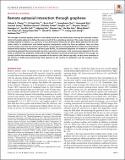Remote epitaxial interaction through graphene
Author(s)
Chang, Celesta S; Kim, Ki Seok; Park, Bo-In; Choi, Joonghoon; Kim, Hyunseok; Jeong, Junseok; Barone, Matthew; Parker, Nicholas; Lee, Sangho; Zhang, Xinyuan; Lu, Kuangye; Suh, Jun Min; Kim, Jekyung; Lee, Doyoon; Han, Ne Myo; Moon, Mingi; Lee, Yun Seog; Kim, Dong-Hwan; Schlom, Darrell G; Hong, Young Joon; Kim, Jeehwan; ... Show more Show less
Downloadsciadv.adj5379.pdf (1.467Mb)
Publisher with Creative Commons License
Publisher with Creative Commons License
Creative Commons Attribution
Terms of use
Metadata
Show full item recordAbstract
The concept of remote epitaxy involves a two-dimensional van der Waals layer covering the substrate surface, which still enable adatoms to follow the atomic motif of the underlying substrate. The mode of growth must be carefully defined as defects, e.g., pinholes, in two-dimensional materials can allow direct epitaxy from the substrate, which, in combination with lateral epitaxial overgrowth, could also form an epilayer. Here, we show several unique cases that can only be observed for remote epitaxy, distinguishable from other two-dimensional material-based epitaxy mechanisms. We first grow BaTiO
<jats:sub>3</jats:sub>
on patterned graphene to establish a condition for minimizing epitaxial lateral overgrowth. By observing entire nanometer-scale nuclei grown aligned to the substrate on pinhole-free graphene confirmed by high-resolution scanning transmission electron microscopy, we visually confirm that remote epitaxy is operative at the atomic scale. Macroscopically, we also show variations in the density of GaN microcrystal arrays that depend on the ionicity of substrates and the number of graphene layers.
Date issued
2023-10-20Department
Massachusetts Institute of Technology. Department of Mechanical Engineering; Massachusetts Institute of Technology. Research Laboratory of Electronics; Massachusetts Institute of Technology. Department of Materials Science and EngineeringJournal
Science Advances
Publisher
American Association for the Advancement of Science
Citation
Celesta S. Chang et al. ,Remote epitaxial interaction through graphene.Sci. Adv.9,eadj5379(2023).
Version: Final published version